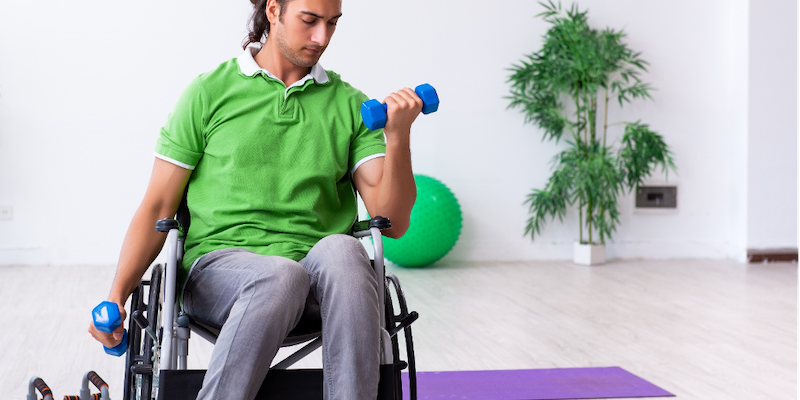Getting hurt in an accident is a terrible thing to go through, and so is recovering from a seriously debilitating physical illness.
If you’ve been injured or ill and feel like you’re never going to recover and get back to living a normal life in Lynchburg, you’re not alone. Millions of people go through serious physical setbacks each year and feel this way.
Fortunately, many of them DO recover and go on to lead happy, fulfilled lives. It takes a lot of hard work and focus to get past a serious physical injury or illness, but it is possible even if you need the help of a rehab chair.
The tools you use on your way to recovery can make a big difference. You can choose from a variety of medical equipment, all of it has been designed to help people get the rehabilitation they need even if they are in a mobility device.
Since so many different types of recovery equipment exist, it helps to get an overview of them. Here’s a look at the types of healing medical devices you can expect to use.
-
Practice Stairs and Ramps if You Still Have Function in Your Legs
Part of recovering from serious physical injury is getting to where you can move again. Even if you’ve only been in bed for a few days, you’ll notice feeling a bit weaker and less steady.
Don’t panic. It’s normal to feel weird at first, but you will get moving again before you know it.
If you still have the use of your legs physical therapists have practice ramps and stairways that help you re-learn to walk up structures. They’re great for the period after you get a leg cast removed and start to put weight on your leg or foot again.
These kinds of structures are not tall. They may have two or three stairs in total. So, if you happen to fall, you won’t be re-injured. Obviously this is not an option if you cannot move the lower half of your body, but that doesn’t mean you’re out of luck.
-
Strength Building Tools
Getting back to normal means building your strength back up, a little at a time. Nearly all types of rehabilitation use strength-building exercises.
Lifting weights, even small ones, is a powerful recovery practice. You can use kettlebells and hand weights in different sizes, gradually building up to higher amounts of weight.
If weights just aren’t your thing, it’s okay. Resistance bands do the job just as well. They’re like giant rubber bands that you stretch. They work by building up your muscle groups with resistance.
Most strength-building tools can fit nicely inside a suitcase, so you can take them wherever you go. Vacation, a friend’s house, or even a nice park in Lynchburg. You don’t have to use the gym to work on strength building.
-
Tables and Platforms
Physical therapists use different types of rehabilitation equipment to help patients regain their mobility. Comfortably cushioned, they allow patients to limber up tight muscles and joints.
Physical therapy tables can include alignment tables and tilt tables. Therapists also like to use large, raised therapy mat platforms that allow for a range of movements and don’t constrict space.
If you’ve been flat on your back for a while, a tilt table can help you get re-oriented to sitting up straight. This includes overcoming bothersome symptoms like passing out when you try to sit up because of blood pressure changes.
Some tilt tables can rotate a patient completely upside down, so they experience gravity in reverse. This is especially useful for decompressing a sore back and helping your spine naturally unkink.
Most tables used in rehabilitation services are adjustable. This is because they need to raise or lower to accommodate patients in wheelchairs or crutches.
-
Electro-Stim Machines
Other effective rehabilitative medical devices you may encounter in your recovery include electrostimulation devices. They attach to your body with adhesive pads and stimulate it with a mild electrical current.
They don’t “shock” or hurt you. The sensation is a mild vibration that feels like a massage.
Electro-stim is especially helpful after a vigorous workout when your muscles are inflamed and swollen. It has a slight numbing effect, which helps you feel better after a tough workout.
-
Braces and Supports
Braces and supports are very common types of motility devices used during physical recovery. Almost everyone has used a brace or walker at some time or another.
If you have to wear a brace while you’re healing after an injury, don’t be embarrassed about it. It is more important that you get your range of motion back and heal correctly than it is to look good or worry about appearances.
How to Choose the Right Medical Equipment for Your Recovery in Lynchburg
So now you know about some of the most popular categories of rehabilitation equipment you can use in your recovery. Choosing what works is not an exact science, so don’t be afraid to experiment.
You have so many quality medical devices to choose from, so try them all until you find what works for you.
If you have questions about ordering custom medical devices, get in touch with us. We supply a variety of specialty wheelchairs and other medical equipment.
Over the years we’ve helped many people get their lives back by using quality rehabilitation equipment. We serve the Carolinas and Georgia and can come to your home to do a mobility assessment.
To schedule an appointment with one of our mobility experts, contact us today.

